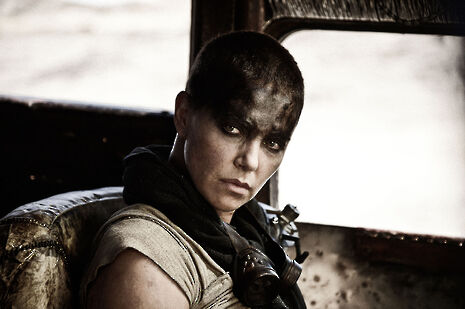Film: Mad Max: Fury Road
A welcome addition to the Mad Max series, writes Libby Parry-Hughes

With Mad Max: Fury Road, veteran director George Miller revives the series which made his name – and Mel Gibson’s – and delivers a film which in frenzied, gasoline-propelled insanity, lives up to its billing.
Captured and enslaved by a tyrannical warlord, Immortan Joe (Hugh Keays-Byrne), Max (Tom Hardy) is compelled into an alliance with renegade Imperator Furiosa (Charlize Theron) as they make a high-speed escape through terrifying desert landscapes. The pursuit promises to be unrelenting: Furiosa has made off with the warlord’s favourite wives, rescuing them from sex slavery, and a convoy of his War Boys is fanatically determined on bringing them back.
Although the extended chase premise undoubtedly recalls 1982’s The Road Warrior, it is the sprawling post-apocalyptic deserts of Max’s much-maligned third outing in Beyond the Thunderdome that are being channeled more clearly, albeit pushed to another level: the landscapes here are of a Biblical grandeur, and totally removed from the first installments’ recognizably Australian location. There is a real, thudding kinetic energy as the War Boys – flailing, thrashing white devils – fill these vast expanses to make a vision that is not so much post-nuclear as hellish: the screen often resembles a Medieval Doom painting writ large.
The religious analogies are deliberate: one of the more-developed subplots concerns Immortan’s cult-like exploitation of religion in order to control his slaves. Running parallel to this are narratives of human-caused ecological catastrophe, and, more prominently again, a defiance of oppressive patriarchal authority which has enslaved women as “breeders”, which has kicked up a storm on the more misogynistic sections of the internet. These subplots create a narrative heft, certainly, but in some ways this level of engagement detracts from the nihilism of the earlier films – particularly The Road Warrior – where there was often little sense of anything but road, and survival instinct.
Fury Road is easily at its best when running on gasoline-fuelled adrenaline, rather than its extensive plot: it during the thudding action sequences that the film manages to tap into a furious, primal drive, and starts to create the unhinged hysteria the title describes. If extensive CGI means a loss in the sense of precariousness arising from lower-budget predecessors’ rattling, literally-unhinged vehicles, Miller is careful to suggest the materiality of his super-trucks and more than makes up for it in the chaotic scope of the fleet.
It is Hardy, as Max, who gets top billing, but he is noticeably in the back seat for much of the film – it’s Theron who takes the lead in almost every capacity. There are nagging problems here, not so much with the very welcome characterization of Furiosa, but with the near-redundancy of the Max character. The film simply doesn’t seem to know what to do with him: served with the generically haunted backstory, his contributions are rarely vital, or even all that mad. It’s almost as if the film has tried to deal with a Gibson-sized hole by writing the character into the background.
In any case, though, this is a welcome addition to the Mad Max series, and easily the best blockbuster you’re going to see all summer.
Mad Max: Fury Road is currently showing in cinemas across Cambridge and the UK.
 News / Downing investigates ‘mysterious’ underground burial vault 29 December 2025
News / Downing investigates ‘mysterious’ underground burial vault 29 December 2025 News / Unions protest handling of redundancies at Epidemiology Unit30 December 2025
News / Unions protest handling of redundancies at Epidemiology Unit30 December 2025 Lifestyle / Ask Auntie Alice29 December 2025
Lifestyle / Ask Auntie Alice29 December 2025 Features / ‘Treated like we’re incompetent’: ents officers on college micromanagement30 December 2025
Features / ‘Treated like we’re incompetent’: ents officers on college micromanagement30 December 2025 Science / Astronomical events to look out for over the break29 December 2025
Science / Astronomical events to look out for over the break29 December 2025









